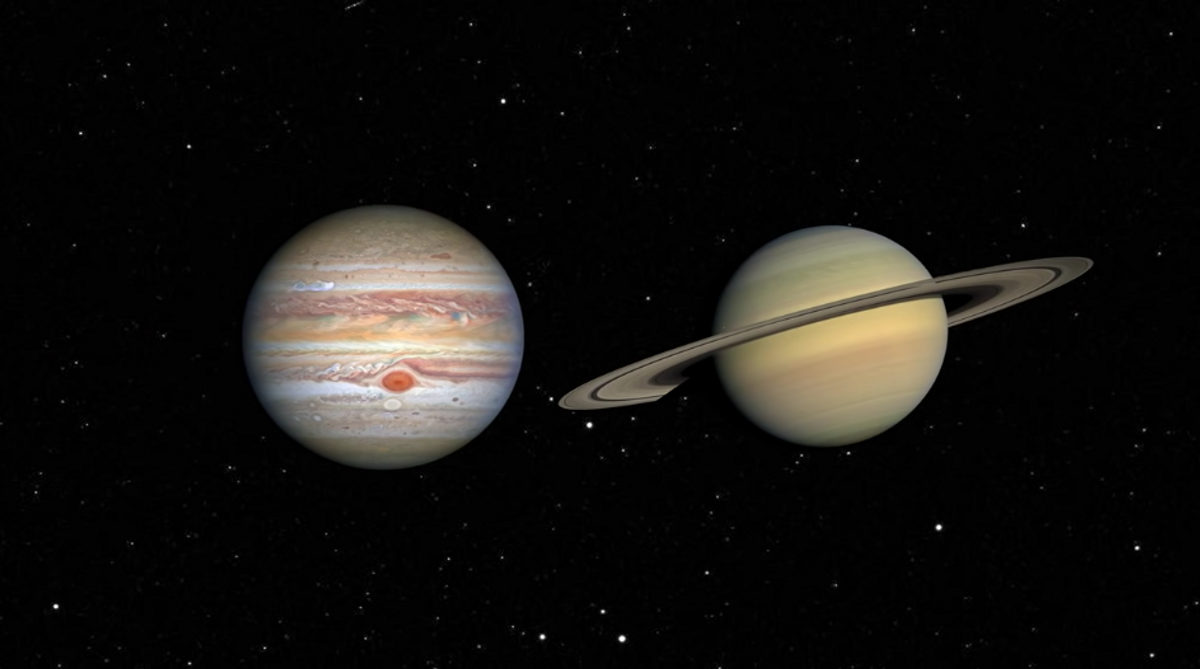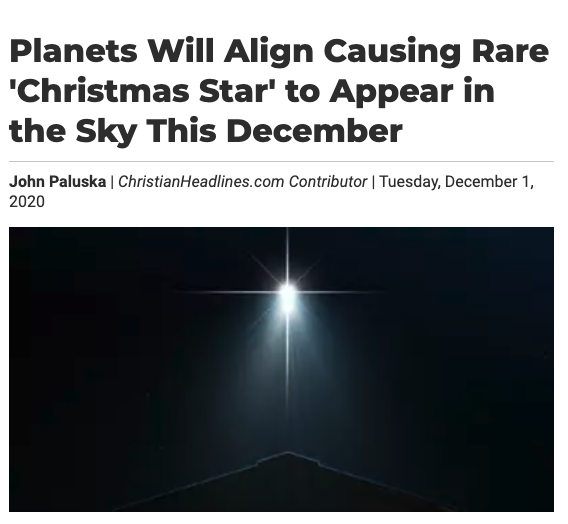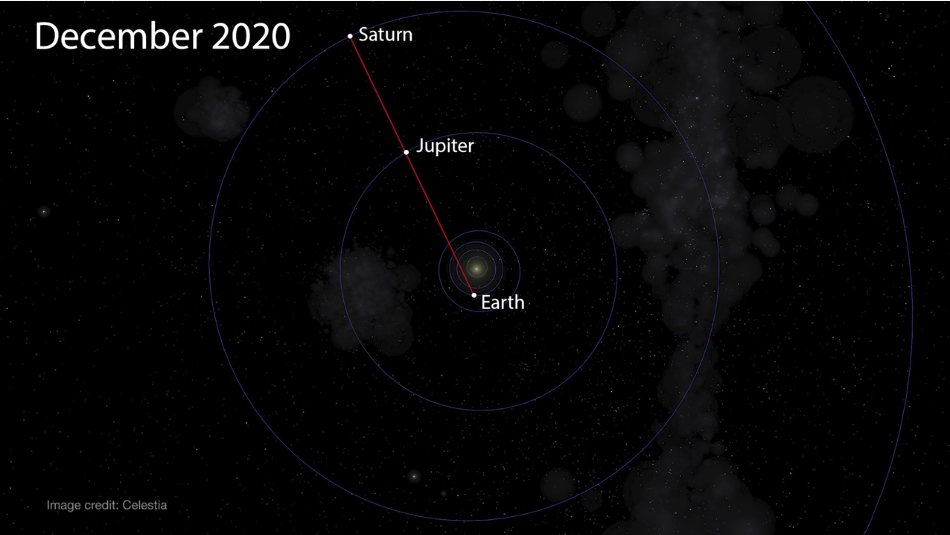Jupiter and Saturn were traveling together across Earth's sky in 2020, and would temporarily align toward the end of December. While the planets' orbiting patterns cause such a phenomenon roughly every 20 years, scientists said the distance separating them on Dec. 21, 2020, would be exceptionally small, compared to past decades and centuries.
No verifiable evidence indicated the celestial occurrence would resemble a "Christmas star" similar to the one mentioned in the biblical account of Jesus' birth.
On Dec. 1, 2020, a Christian media organization published a web page that alleged Saturn and Jupiter would line up in Earth's night sky to create "a beautiful bright star" on Dec. 21, three nights before Christmas Eve, and the date of winter solstice. The page's headline read: "Planets will align causing rare 'Christmas Star' to appear in the sky this December."
Several Snopes readers contacted us to investigate the claim.
It was true that Jupiter and Saturn were traveling across Earth's sky together in 2020, as shown by online orbit simulators and confirmed by space agencies including NASA. That agency's Jet Propulsion Laboratory, which manages robotic missions, said in a video:
Over the first three weeks of December, watch each evening as the two planets get closer in the sky than they've appeared in two decades. Look for them low in the southwest in the hour after sunset. And on December 21, the two giant planets will appear just a tenth of a degree apart. That's about the thickness of a dime held at arms length.
This means the two planets and their moons will be visible in the same field a view through binoculars or a small telescope. In fact, Saturn will appear as close to Jupiter as some of Jupiter's moons. This event is called a great conjunction. These occur every 20 years this century, as the orbits of Earth, Jupiter, and Saturn periodically align [shown in the image below], making these two outer planets appear close together in our nighttime sky. Even so, this is the greatest great conjunction between Jupiter and Saturn for the next 60 years, with the two planets not appearing this close in the sky until 2080.
In other words, Saturn and Jupiter, which orbit in a counterclockwise direction as viewed from Earth's north pole, were moving closer together — often viewable around sunset, low in the western sky — over the course of weeks in December 2020. This was a typical pattern based on the pace of their orbits every roughly 20 years or so.
But the exceptionally close distance between the two planets in December 2020 was what made the phenomena special, according to scientists. Around dusk on Dec. 21, Saturn and Jupiter will be separated by 0.1 degrees, or less than a third of the moon's width, Michael Brown, an astronomer at Monash University in Australia, told The Washington Post.
“You can actually see it with your own eye. It doesn’t have to be measured with sophisticated instruments,” he said. “The two objects are appearing very close in the sky, but ultimately they’re very far away from each other.”
The last time the two planets were equally close was in 1623, only 14 years after the Italian astronomer Galileo Galilei made his first telescope, according to a news article by Deborah Byrd's EarthSky (formally a NPR-syndicated show) and a video lecture by Matthew Bate, a professor of theoretical astrophysics at the United Kingdom's' University of Exeter. The EarthSky article read:
"[That] conjunction was only 13 degrees east of the sun (closely following the sun at sunset), and it is considered unlikely that it was noticed by many."
Furthermore, Rice University astronomer Patrick Hartigan said the Saturn-Jupiter conjunction of 1632 was not viewable via the naked eye from most locations on Earth; glares from the sun made the occurrence nearly impossible to see. He wrote in an analysis:
[The] last time the two planets appeared this close to one another in the sky and were observable (i.e. not in the Sun's glare) was on the morning of March 4, 1226! That was back in the Middle Ages, when the Notre Dame Cathedral was first being built. For this [2020] conjunction, both planets will be visible in the same field of view in most small telescopes, along with some of Jupiter's and Saturn's moons [...]. In fact, they will be so close it may be a challenge to separate them with the unaided eye for some people.
All of that said, it is true that, when the sun starts to set on Dec. 21, 2020, people in most locations will see Jupiter and Saturn aligned like a "binary planet," as Hartigan put it, and that sight would be rare.
However, he said it's false to describe the phenomenon as the two planets suddenly making a "brilliant Christmas star," otherwise known as the "Star of Bethlehem."
According to Christian doctrine, Magi, or wise men, followed the guiding star to Bethlehem, where they paid homage to the infant Jesus. "Where is the child who has been born king of the Jews? For we observed his star at its rising, and have come to pay him homage," they say in the Gospel of St. Matthew.
Dr. Richard Tresch Fienberg, a press officer for the American Astronomical Society, said in an email to Snopes:
Astronomers and historians have debated for centuries whether the legend of the Magi and the Star of Bethlehem is allegorical or refers to a real celestial event. Among the keys to the debate is identifying the actual date of birth of Jesus of Nazareth. Various dates have been inferred based on historical evidence, and astronomers have then used computers to look at what was in the sky on those dates. [...]
The debate will likely rage on ad infinitum (or ad nauseum, depending on your point of view). In any case, any time there’s something bright and notable in the dawn or dusk sky in late December, it inevitably becomes labeled a “Christmas Star.”
In sum, while it was accurate to state that the two planets would align on Dec. 21, 2020, and that that alignment has been a rare occurrence throughout centuries, no scientific evidence showed it would resemble the "Christmas star" to which the Gospel of Matthew refers in the telling of Jesus' birth.



